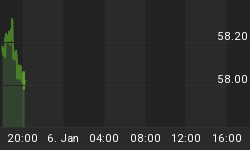
Source: www.macrotrends.net
If anyone thought that the US's standard of living was all about how hard they worked, productivity gains and technology innovations to make modern life easier than they may not be blamed for living under the illusion that has not come without a cost. What this chart would seem to suggest is that the biggest contributor to growth in GDP and by extension the rise in the stock market is that it is all about the debt.
At one time back in the mythical 1950's it only took about $1.30 in new debt in order to purchase a $1 of GDP. Today it takes over $3.50 in new debt to purchase an additional $1 of GDP. Some believe that is conservative.
Since the Great Recession got underway with the crash of 2008 total debt as reported by the Federal Reserve Flow of Funds has increased by over $6 trillion while GDP has grown only about $2 trillion. The biggest portion of the debt increase in the past 5 years has come largely in the government sector. The increase in the Federal Reserve Flow of Funds report only takes into account the growth in the US publically held debt and not the debt held by the government itself. Since 2007, the gross debt of the US government has grown by $7.9 trillion from just over $9 trillion to $16.9 trillion today.
The huge increase in debt has not resulted in a huge surge forward by GDP. What it seems to suggest is that even more debt would be required in order to grow GDP at a faster rate. A debt implosion was behind the collapse in 2008. The collapse was in the banking system. It was, however, the US government backed by the taxpayer that bailed out the banks preventing an even larger collapse. If another banking collapse was to take place now it would not be the taxpayer providing a bail out. The new word is bail-in and there is no guarantee that the Federal Deposit Insurance Corporation (FDIC) could provide the funds for those depositors with under $100,000. The FDIC was effectively bankrupted during the 2008 financial collapse.
The US government debt that now stands at $16.9 trillion pales beside the unfunded liabilities of Social Security, Medicare and Prescription Drug. The unfunded liabilities are estimated to be upwards of $125 trillion. Yet in the US today there is little or no plan in place as to how these future liabilities are to be funded. Except by more debt it seems. If the current debt appears to be in the category of "never will be paid" then the unfunded liabilities would seem to exist in some sort of fantasyland.
Municipalities, corporations and US states are finding that earlier promises to retirees are no longer feasible. The shortfall in US public employee pensions is estimated to be in the area of $1 trillion to $4 trillion. Unfunded pension obligations in the corporate sector could range from $250 billion to $1 trillion. A looming crisis that is not being accounted for.
Against this backdrop there are over 11 million unemployed workers (U3 headline unemployment) and when one counts discouraged workers and marginally employed workers seeking full-time employment there are 21.8 million unemployed (U6). In the US today, some 50 million are considered to be living in poverty and 47 million are on food stamps. Some grocers estimate that upwards of one-third of their revenue comes from food stamps.
Yet all of the talk is of the "taper". Since the 2008 financial crash there has been QE1, QE2, Operation Twist and now QE3. Despite the bond buying by the Federal Reserve, the big money financial institutions still have billions of dollars of loans and paper on their books that is underwater. Clever accounting regulations hide the potential losses. Despite the Fed purchasing $85 billion a month in US Treasuries and mortgage backed securities (MBS) the velocity of money has plunged to record low levels. This suggests that the money being provided to the financial institutions through QE3 is not getting into the broader economy.
Since the crash of 2008 what GDP growth there has been has been fueled by debt, the stock market has been fueled by debt yet unemployment remains persistently high and GDP growth, such as it is, is anaemic at best and at worst the US economy has never left the recession. A financial crisis doesn't just happen overnight. It percolates and takes time to develop. Long-term interest rates have been rising since bottoming in mid-2012. The US$ that so many believed was headed to higher levels has over the past few weeks been in the throes of a breakdown. The stock market is showing signs of topping. When a crisis gets underway things can become unravelled quite quickly as everyone saw in 2008.
At the heart of it all is the debt. There is just too much of it and debt collapses are what Great Recessions (and Depressions) are all about.
















